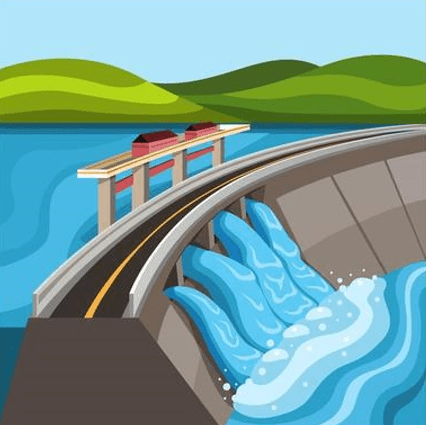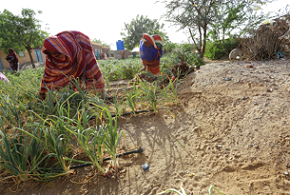Introduction
A dam is a man-made obstruction built across a river or underground stream to restrict the flow of water. This results in the creation of artificial lakes or reservoirs. Then, this has other uses. such as irrigation, domestic purposes, flood control, commercial purposes, aquaculture, electricity production, etc. They used bricks, clay, concrete, cement, iron riding, etc. to build their construction. Even though it provides a lot of benefits, there are some drawbacks as well. The environment of the river will be impacted when more dams are built over it. due to the abundance of aquatic life in the river. There is therefore a pressing need for a dam alternative.

Advantages of Dams
A dam has several advantages, ranging from economic to social advantages. The following is a list of benefit of a dam.
- Water storage: It can serve as a sizable water reserve that can be used for domestic, commercial, and agricultural purposes. Additionally, it has the capacity to accept extra surface water.
- Recreation: Dam’s are a point of public attraction as many leisure activities like boating, camping, swimming, etc. can be done in this area.
- Irrigation:The dam is a significant source of water for irrigation.
- Debris control: The dam has improved environmental protection by reducing the amount of trash thrown into rivers.
- Electricity production: Hydropower is a crucial source of electricity because it doesn’t produce any chemical waste. The majority of the nation’s primary source of electricity is generated from water.
Disadvantages of Dams
Dams are constructed to generate additional electricity for use by people. However, the bulk of these dams are unable to make a significant impact on the generation of power for human needs. Instead, it has certain negative repercussions on both the ecology and people as a whole. Some of them are mentioned below-
- Dam construction has an negative impact on the aquatic life that exists in the water.
- There is lots of water wastage during the process of dam construction.
- It has affected the people who live nearby as a sizable portion of land has been buried to serve as a water reservoir.
- Due to dam construction biodiversity in the water has reduced.
- There is an increased sediment accumulation
- Soil erosion has occurred in places nearby to the dams.
- There is a danger of catastrophe because by chance if the dam structure breaks it will threaten the lives of thousands of people,
- Overflow of water in the dam may happen if more water reaches the surface by rain which might lead to flooding in the nearby areas.
Alternative solutions to Dams
Dams have a number of drawbacks since they are not the ideal solution for meeting human requirements. Therefore, finding a dam replacement is essential. Some of the alternative solutions to dams are given below-
- Concentrating on alternative energy sources-The construction of dams is a result of the rise in electricity demand; therefore, finding an effective source of energy production will lessen the danger posed by dams. Some common alternative energy sources ares nuclear power plants, thermal power plants, solar electricity, wind power, etc.
- Reuse of water: The dam provides water for numerous uses that. Therefore, locating new alternate water sources can also help to lower the number of dams. For instance, sewage water can be recycled and used again for a variety of various purposes, including industrial and agricultural ones.
- Managing flood: By reducing the water runoff we can control the flood of many rivers. Since dams play a prominent role in the prevention of floods in rivers.
- Concentrate more on the current dams: Only small a fraction of dams are used effectively. Hence,prior to building a new dam, one must pay attention to the older dams and make the best use of them.As a result, fewer dams may be constructed to bridge rivers.
- Groundwater recharge: Increased water deposition from surface water to groundwater is known as groundwater recharge. This process increases the water content below the ground level which can be used for various other purposes.
Summary
Water is a priceless resource that is essential to maintaining human life. It may be used for everything from generating electricity to drinking puropses. Consequently, a reliable water source is always going to be required. A dam is a man-made structure designed to preseve water. Nevertheless, while there are numerous benefits of dams, there are also some drawbacks. Being a man-made construction, it has a severe impact on the ecosystem around us. Therefore, a water resource other than the dam is desperately needed. Alternative methods of dams include replenishing the groundwater table, locating alternate energy sources, etc. If appropriate measures are not taken into consideration, we could face a number of issues. And hence for this purpose new technologies must be implemented..
Frequently Asked Questions
1. Which of the dams on Earth is the oldest?
Ans: The dam Jawa, which is situated in Jordan, is the oldest dam still in use today. There are still some of this dam’s remains.
2. How long do dams last?
Ans: A dam’s lifespan is estimated to be 50 years on average. In this lifespan, it can function successfully. There are also other dams that date back far more.
3. Can a dam contaminate water?
Ans: Since dams stop the flow of water, they can accelerate the growth of any existing microbes in the water, which can render the water hazardous. The number of diseases spurred on by water pollution has been rising daily. Additionally, metallic components can also accumulate in such stagnant waters which can further harms marine life.


